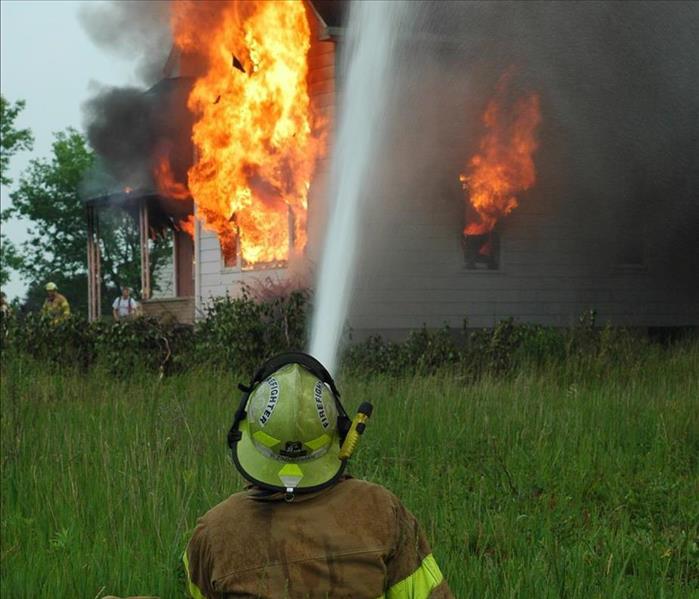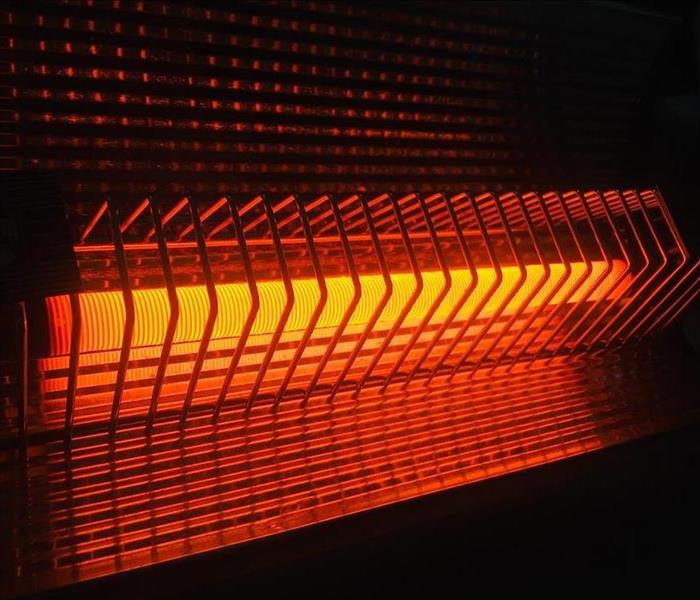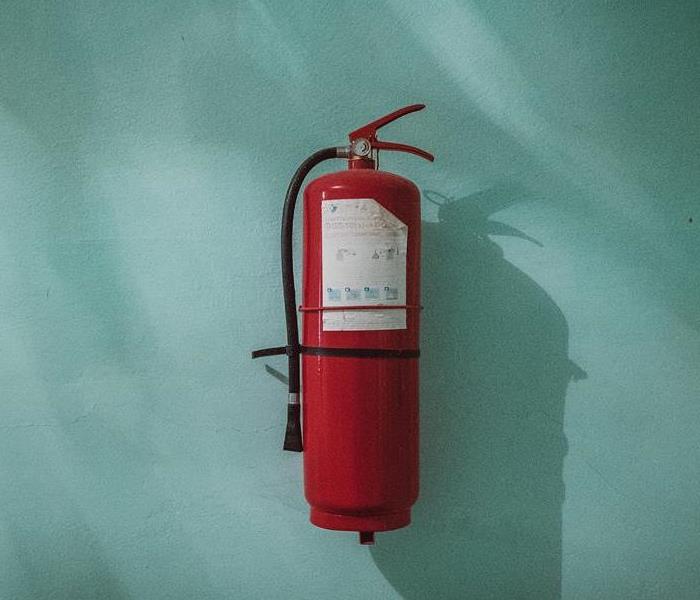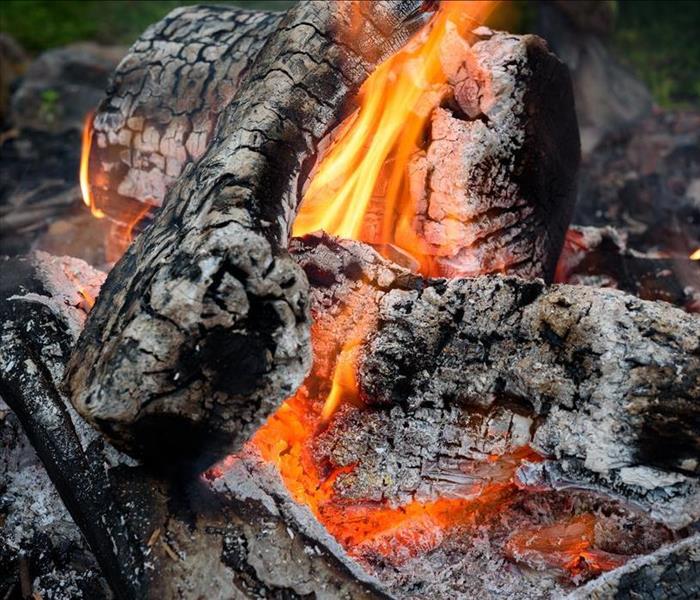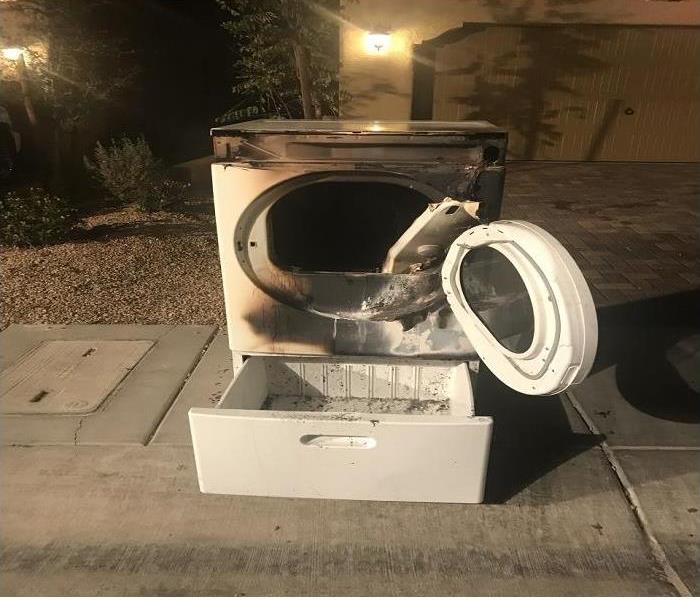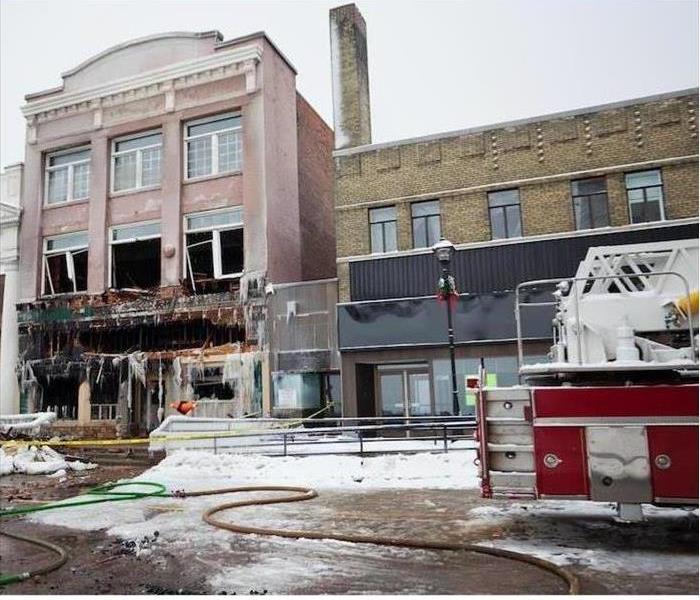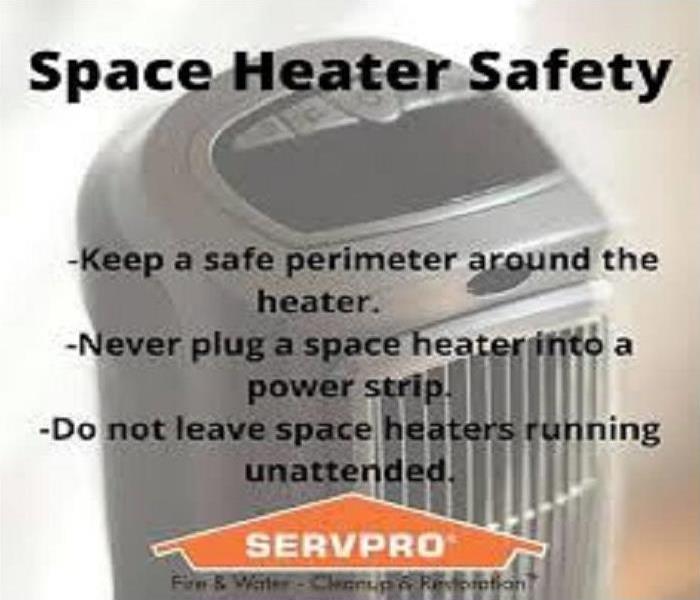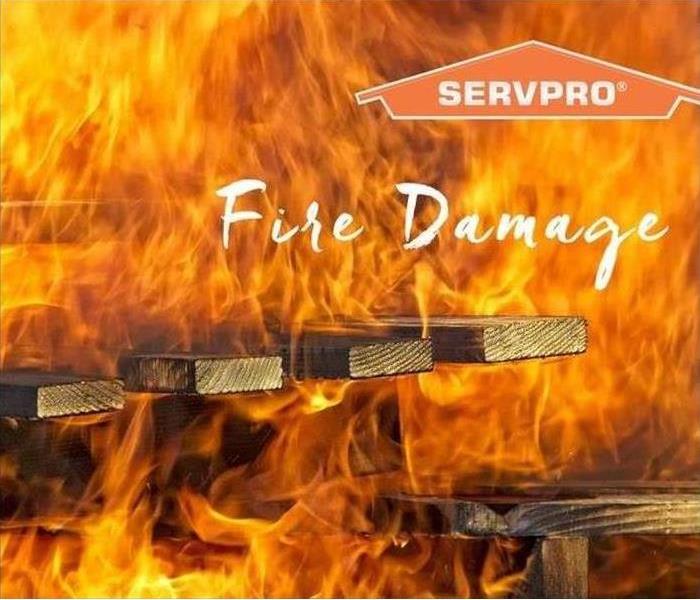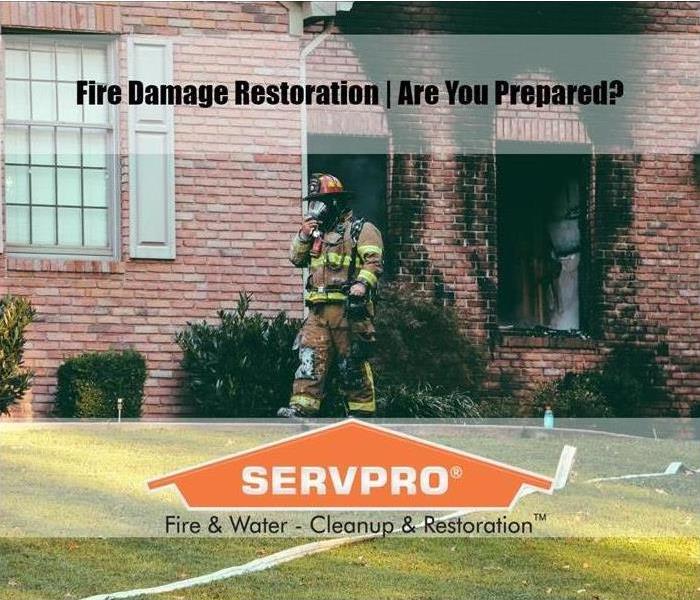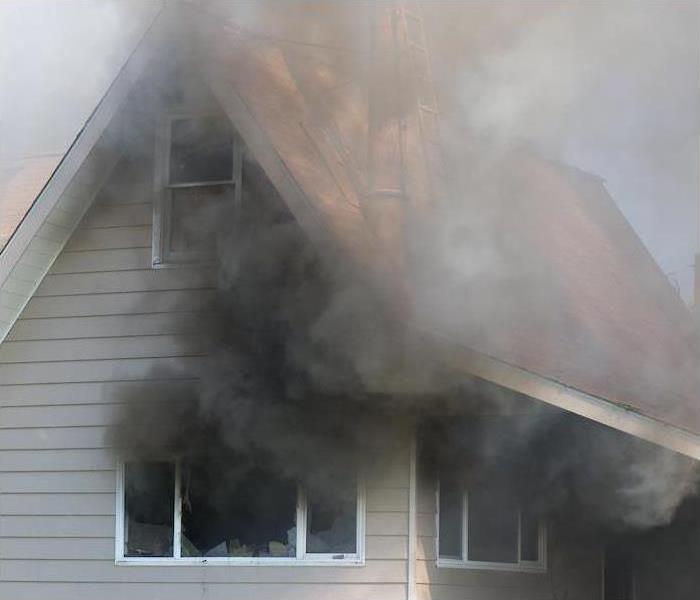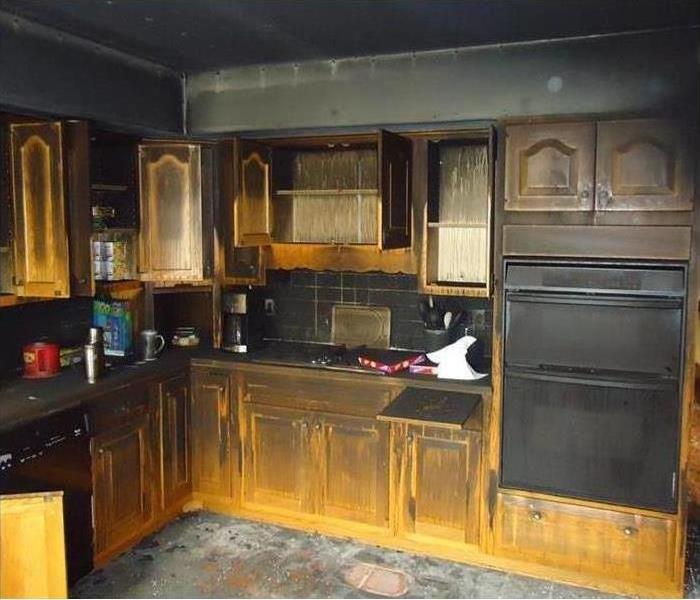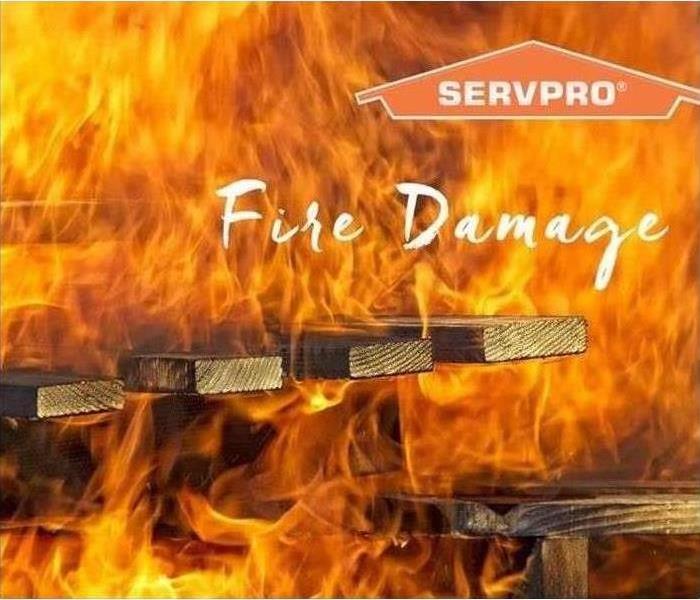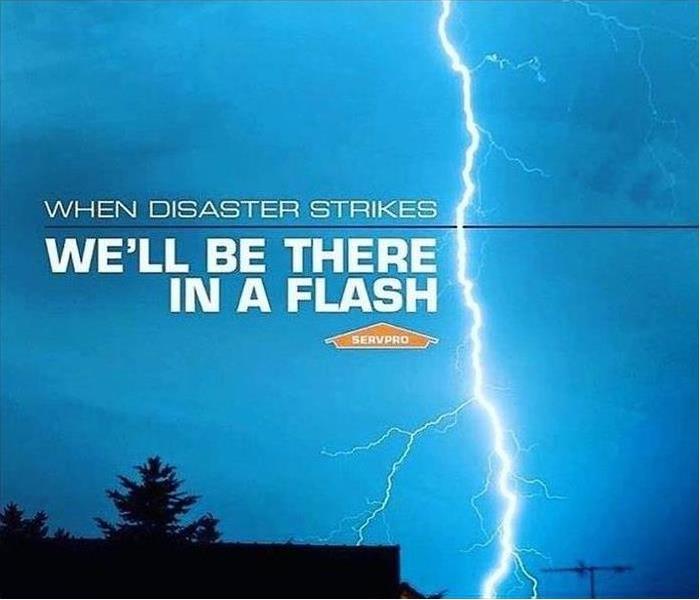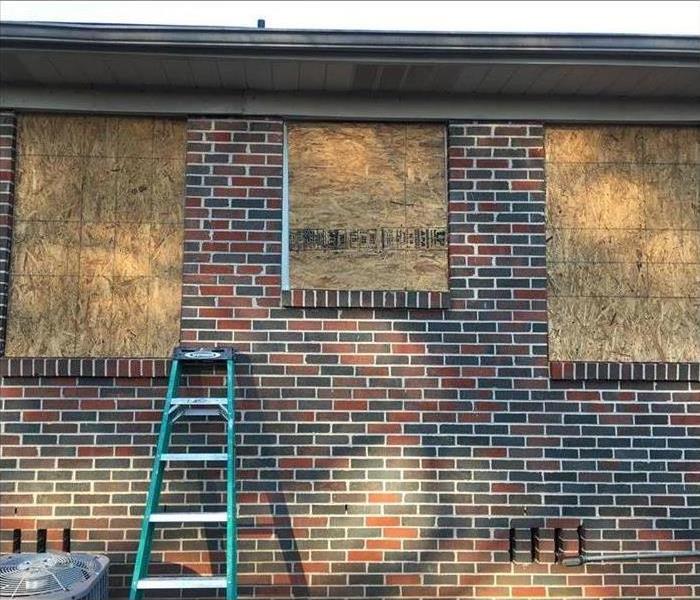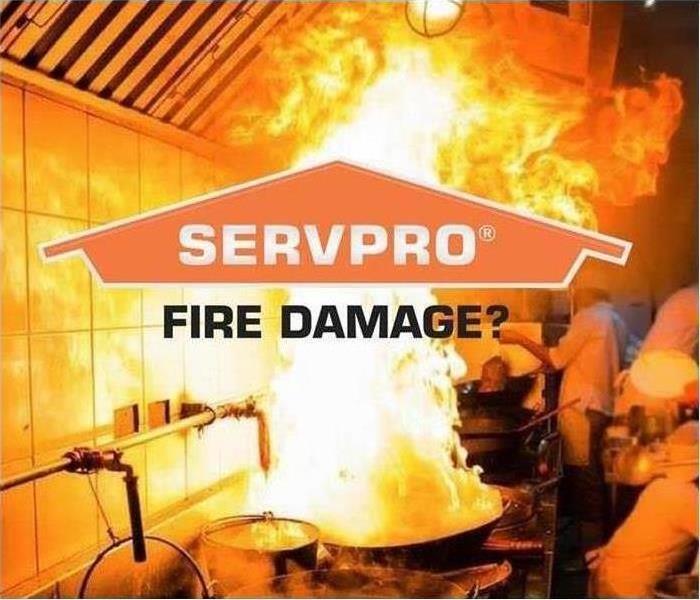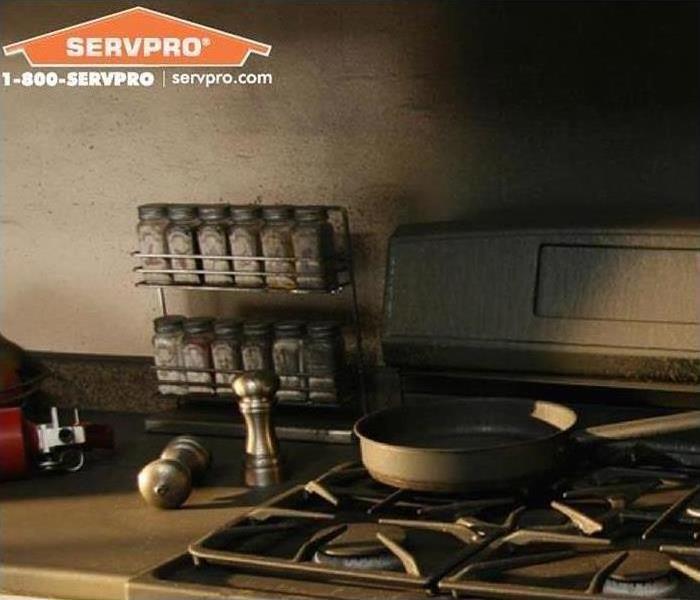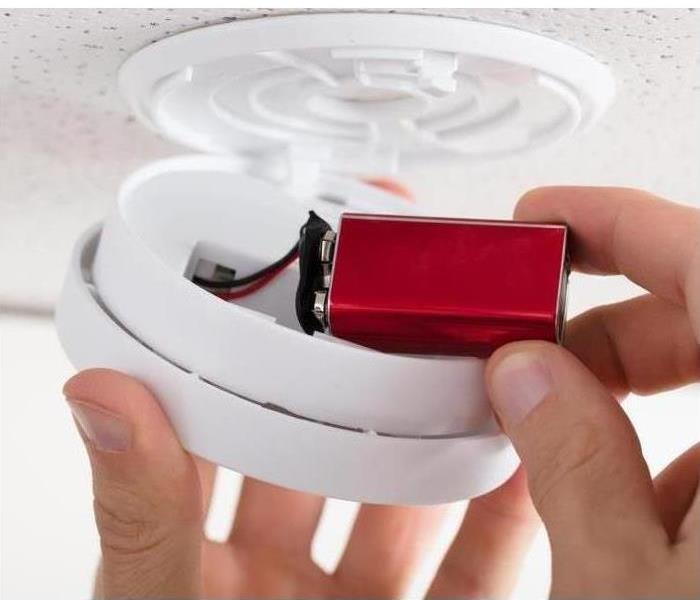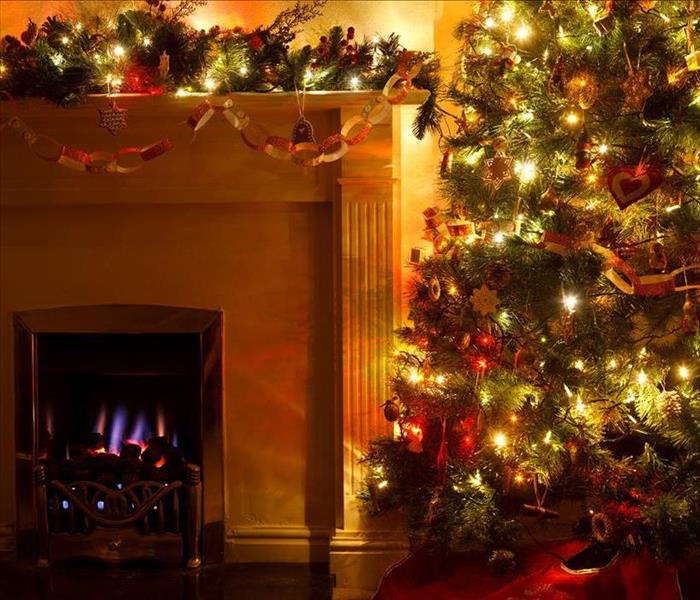Archived Fire Damage Blog Posts
Spring Safety: Top 3 Fire Hazards Around Your Home
3/25/2024 (Permalink)
As the weather warms up and springtime activities begin, it's crucial to be aware of potential fire hazards that can pose risks to your home. Here are the top three fire hazards to watch out for in and around your home during the spring season:
1. Grilling: Spring often means firing up the grill for outdoor cooking, but improper use can lead to dangerous fires. Ensure your grill is positioned away from flammable materials, such as overhanging branches or wooden decks. Keep a fire extinguisher nearby and never leave the grill unattended while in use.
2. Yard Debris: Spring cleaning may involve clearing yard debris such as dry leaves, branches, and dead vegetation. However, these materials can easily ignite if not disposed of properly. Avoid burning yard waste on windy days and always follow local regulations for outdoor burning. Consider composting or using designated disposal methods instead.
3. Electrical Wiring: With spring comes an increase in outdoor activities and the use of electrical equipment such as lawnmowers, trimmers, and power tools. Inspect electrical cords and outlets for signs of damage or wear, and never overload circuits with too many devices. Keep electrical equipment away from water sources and store them properly when not in use.
By staying vigilant and addressing these common fire hazards, you can help protect your home and family during the spring season. Remember to also have working smoke detectors installed throughout your home and develop a family fire escape plan in case of emergencies. For professional fire damage restoration and cleanup services, trust SERVPRO to be there when you need us most. Stay safe this spring!
Fire Damage Restoration Process
5/9/2022 (Permalink)
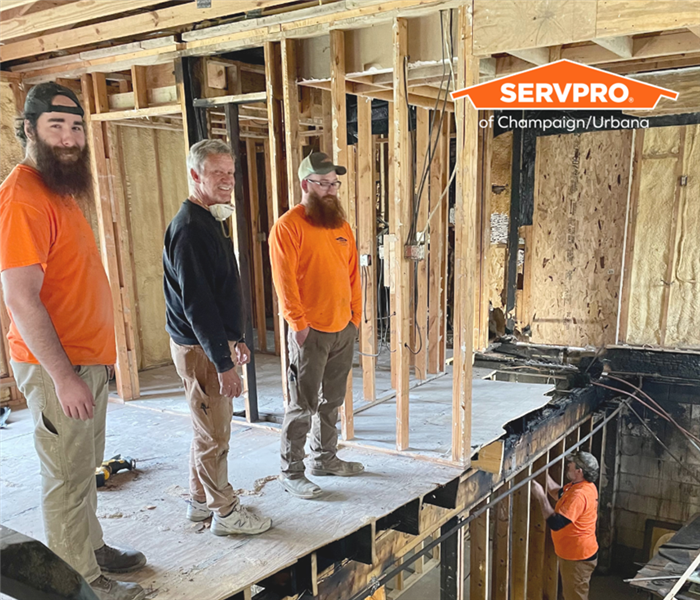 A kitchen fire that caused damage to the entire house
A kitchen fire that caused damage to the entire house
After the fire trucks leave, your home likely suffers from fire and smoke damage and extensive water damage from firefighting efforts. SERVPRO of Champaign/Urbana have the specialized fire restoration training needed to restore your home to pre-fire condition.
Have Questions About Fire, Smoke, or Soot Damage? Call Today – (217) 355-0077
Every fire damage event is a little different, and requires a unique solution, but the general process stays the same. The steps listed below illustrate our process for the “typical” fire damage emergency.
Step 1: Emergency Contact
The restoration process begins when you call us. Our representative will ask questions regarding the fire damage event that will help us respond immediately with the appropriate equipment and resources.
Step 2: Inspection and Fire Damage Assessment
We carefully inspect and test adjoining rooms of your property to determine the extent of the fire, smoke, and soot damage. This step is crucial to developing a plan of action.
Step 3: Immediate Board-Up and Roof-Tarp Service
Fire damage can often compromise windows, walls, and roofs. To maintain security and to protect against further damage, we can board up missing windows and walls and place tarps on damaged roofs.
Step 4: Water Removal and Drying (if water damage is present)
The water removal process begins almost immediately and removes the majority of the water. We then use dehumidifiers and air movers to remove the remaining water and complete the drying process.
Step 5: Removal of Smoke and Soot from All Surfaces
We use specialized equipment and techniques to remove smoke and soot from ceilings, walls, and other surfaces.
Step 6: Cleaning and Sanitizing
We clean, sanitize, and disinfect all of the restorable items and structures that were damaged by the fire. We use a variety of cleaning techniques to restore your belongings to pre-fire condition. We’re also trained to remove odors using industrial air scrubbers and fogging equipment.
Step 7: Restoration
Restoration is the final step—getting your home or business to its pre-fire condition. Restoration may involve minor repairs, such as replacing drywall, painting, and installing new carpet; or it may entail major repairs such as the reconstruction of various areas or rooms in a home or business.
Most Common Causes of House Fires
2/28/2022 (Permalink)
Fires can start in the smallest of ways and turn into the biggest problems. It's important to check your home regularly and be aware of the most common ways a fire can start to protect you and your family.
So, what are the most common ways that a fire can start in your home?
- Lighting: Most people do not think that lighting can be the cause of a home fire. Make sure that lamps cannot be knocked over, and that lamp shades are not too hot.
- Cooking: Be sure to not leave foods that are being cooked on the stove unattended to. If you need to leave the kitchen, ask someone to keep an eye on the food. it is very easy to get distracted by a phone call or tending to a child and forget you have food on the stove.
- Flammable Liquids: Do you keep flammable liquids in your garage? If you answered yes, you are not alone as most people do keep flammable liquids in their garage. Be sure to keep them away from heat sources and check the label before selecting an area for storage.
- Smoking in Bedrooms: It's best to not smoke in bedrooms as the cigarette bud can still be lit for hours after the cigarette bud has been put out.
- Bad Wiring in your Home: If you notice the lights go down with you use a certain appliance, this could be an indication that the wiring in your home is bad. To be safe, have an electrician come out to check.
- Children & Curiosity: Make sure to keep matches, and lighters away from children. Teach your children how to stop, drop and roll just in case!
- Portable Heaters: Be sure to keep portable heaters away from fabrics as they can get really hot and cause a fire.
- Candles: Candles are a great way to add ambiance to your home and fill the room with your favorite scents! Be sure you don't leave candles unattended to, they're kept away from fabrics, and also kept on sturdy surfaces and away from children. Practice these tips so you can continue to enjoy your favorite scents every season.
How To Prevent a Space Heater Fire
2/21/2022 (Permalink)
Space heaters can be useful for keeping an area in your home warmer than the temperature setting on central heating. These appliances can lower costs and increase comfort. An unsafe appliance or one that is not operated properly can lead to a burned space heater and house fire. Follow a few simple measures to safely use a space heater.
Choose a Heater With Safety Features
The right heater can reduce the risk of a fire. Make sure the model you buy has the following safety features:
- Ground fault circuit interrupter plug
- Automatic shut-off for overheating
- Safety certification
- A cord that is six feet or longer
A heater with these features may cost slightly more but should be worth the peace of mind.
Situate a Heater in a Safe Spot
A burned space heater may result if you operate this appliance in a risky location. Make sure the room where you plan to use the heater has an empty outlet, level surface, and sufficient space. You should always:
• Avoid plugging other electronics into the same outlet as a space heater
• Plug the heater directly into an outlet and never use an extension cord
• Keep at least three feet of space between heaters and combustibles such as curtains, bedding, or upholstery
• Situate the heater on a hard, non-flammable, level surface
Attend Operating a Heater
Even an appliance with safety features that is safely situated can still be a fire hazard. Reduce the risk of fire by turning off the appliance when you leave the room. You should never operate a heater unattended around children and pets or leave a heater plugged in when not in use.
It is estimated that space heaters start around 25,000 house fires every year in the United States. If a burned space heater causes a fire in your home in Champaign/Urbana, contact residential fire damage and smoke cleanup specialists. 217-355-0077.
Workplace Fire Safety
2/2/2022 (Permalink)
Fires and explosions are fairly rare in the workplace, but they can be extremely dangerous and costly. Here are the most common causes of commercial property fires and steps to help prevent them.
1. Faulty electrical equipment
The most common cause of workplace fires is electrical issues. Overloaded plugs and loose wires can result in electrical fires. Be certain to minimize the number of devices drawing from one power source.
2. Flammable and combustible materials
Improper storage of some materials is a contributor to fires. Industrial workshops and garages are especially prone. Workplace fire loads vary depending on what is stored in your space. This risk can be lessened simply by ensuring all materials are properly stored away from any potential ignition sources.
3. Lack of staff training
Properly training staff to recognize hazards is critical for avoiding and handling emergency circumstances. Avoiding innocent mistakes like improper material storage or blocking cooling vents on electronics can prevent disasters. A top safety priority should be making sure everyone knows what do to in an emergency including evacuation routes and how to use a fire extinguisher.
4. Lack of resources and equipment
Prevention is key. That means investing in the tools designed to keep people safe - smoke detectors, fire alarms and suppression systems. Without these, a fire can quickly reach a dangerous stage. Smoke alarms are as important in the workplace as they are at home.
About SERVPRO of Champaign/Urbana
SERVPRO of Champaign/Urbana provides 24-hour disaster mitigation service. We specialize in the restoration of homes and businesses suffering losses from fire and smoke, water, flood, wind, and storm damage. Our locally owned and operated 24/7 response team is always just a phone call away. 217-355-0077
Out of the Ashes? What Can and Cannot Be Saved After a Fire
1/5/2022 (Permalink)
A house fire is a horrific event. Even if everyone in the home makes it out safely, the physical damage on the structure will be intense. That pain will only be matched by the acute mental and emotional anguish endured by those living there.
There are many factors that will determine what, if anything, can be saved once the flames are extinguished. Our technicians at SERVPRO of Champaign/Urbana are often surprised by what survives even the most intense fires. Books, wood furniture, tools, certain types of pottery and stoneware might have a life after the blaze. Even pictures and important family documents have been found fully intact under piles of ash and debris.
How does fire damage things and what needs to be thrown out?
Visible fire damage is not hard to spot. What will not be as evident is what has been impacted by extreme heat and flames. Even if there is no apparent physical damage, get rid of certain materials, including:
- Insulation
- All food that was in the house (both perishable and non-perishable)
- Cosmetics
- Medication
- Cleaning supplies
While these kinds of items might have avoided visible fire damage, they may have come in contact with toxic chemicals. Combustion, the process of something burning, releases harmful chemicals like hydrogen cyanide, sulfur dioxide, and tar.
You cannot eat food that has been exposed to heat or the chemicals produced during combustion. Medication, cosmetics, and most cleaning supplies also react negatively with heat and must be discarded. Burned insulation no longer insulates, and it is impossible to clean the accumulated soot and smoke odor. However, our SERVPRO technicians remove the top three to four inches of insulation in case the problem only involves residue deposits.
How we can help?
Fire affects ALL materials at the site. Meticulous and detailed scoping is necessary before deciding what to throw and what, if anything, can be kept. Our SERVPRO technicians consider three main factors:
- Can it be restored?
- How much will it cost?
- What is the sentimental or monetary value of the item?
After a thorough inspection of your property, our technicians can assess when items can be restored. Restoration, not replacement, is always what we strive for initially in an effort to save your belongings and to save you money.
Smoke Alarms In Homes Save Lives
11/29/2021 (Permalink)
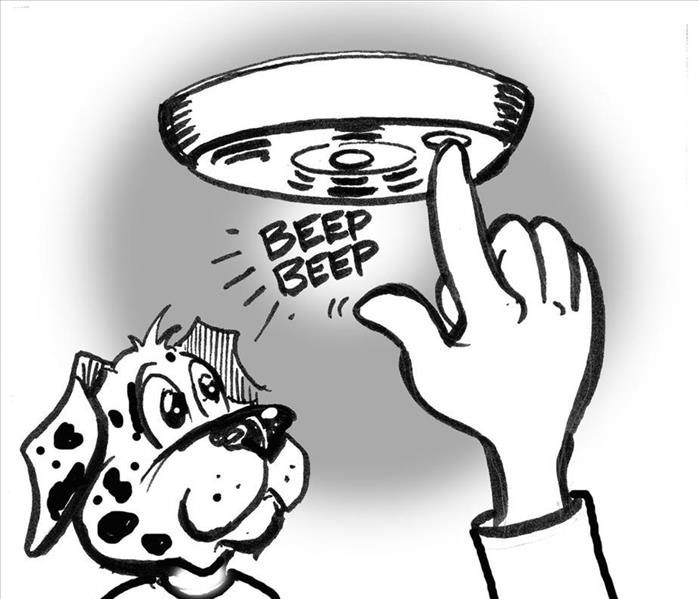 Regular testing of your smoke alarm can make all the difference during a fire
Regular testing of your smoke alarm can make all the difference during a fire
When installed and properly maintained, smoke alarms can dramatically reduce the risk of injuries caused by fires. According to the National Fire Protection Association (NFPA):
Compared to reported home fires with no smoke alarms or automatic extinguishing systems (AES) present, the death rate per 1,000 reported fires was as follows:
- 35 percent lower when battery-powered smoke alarms were present, but AES was not,
- 51 percent lower when smoke alarms with any power source were present but AES was not,
- 69 percent lower when hardwired smoke alarms were present but AES was not, and
- 91 percent lower when hardwired smoke alarms and sprinklers were present
The National Fire Protection Association also recommends the following:
- Install smoke alarms on every level of the home and in every bedroom. Do not install the smoke alarm where it could be blocked or damaged.
- Smoke alarms should be installed away from the kitchen and shower to prevent false alarms. They should be at least around 10 feet from a cooking appliance.
Test smoke alarms at least once a month using the test button. - Replace batteries in all smoke alarms at least once a year, though twice would be best. Daylight savings times in March and November can be good dates to set for this.
- Replace all smoke alarms when they are 10 years old. Newer alarms on the market also offer carbon monoxide detection as well as voice alarms, which have shown to be more effective in waking children up.
Reduce the Risk of Fire in the Kitchen
9/6/2021 (Permalink)
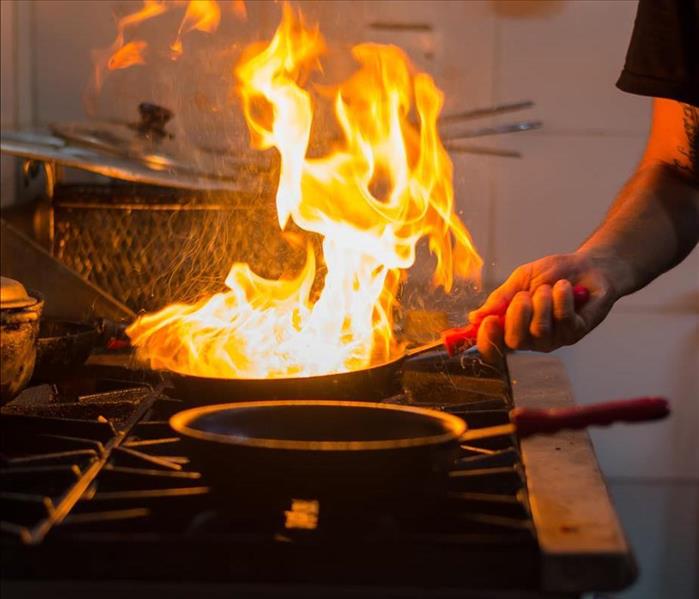 Large flames like this can result in fire damage to your kitchen.
Large flames like this can result in fire damage to your kitchen.
National Fire Protection Association (NFPA) says 6 out of 7 cooking fires occurred while the cook was out of the kitchen, and 2/3rds of these fires happened in the first 15 minutes of cooking. This means that it is imperative that you ALWAYS watch what you’re cooking. If you’re using the stovetop, stay in the kitchen and watch closely. Also, experts recommend setting a timer periodically to remind you to check the oven.
OTHER FIRE PREVENTION TIPS INCLUDE
- Roll up sleeves and don’t wear loose fitting clothing that could catch and open flame or heating element
- Ban children and pets from a 3-foot “safe zone” around the stove
- Keep the stove and oven clean, turn pot handles in to avoid spills and cleanup any messes when appropriate
- Keep potholders, dishtowels, oven mitts, food packaging and other clutter off and away from the stove.
- Clean cooking equipment thoroughly because built-up grease can catch fire.
- Don’t over heat your oils, and wait for grease to cool before disposing, tossing hot grease in a trashcan could turn into a disaster
Smoke detectors are your first line for defense against a fire disaster situation so make sure you have one installed in or near the kitchen and make sure it’s working properly.
IF A FIRE DOES HAPPEN, CONSIDER THESE SAFETY TIPS
- Close the door behind you to help contain the fire and get out of the house.
- Call 9-1-1 or the local emergency number after you leave.
- For an oven fire, turn off the heat and keep the door closed.
- Keep a lid nearby when you’re cooking to smother small grease fires. Smother the fire by sliding the lid over the pan and turn off the stovetop. Leave the pan covered until it is completely cooled.
People often try to put out cooking fires themselves with a fire extinguisher or even water. NEVER use water on any grease fire. Store fire safety equipment in a cabinet or under the sink – it is important to have a fire extinguisher close by as well as a box of baking soda or salt for grease fires. The first step you can take is turning the stove off and having a lid handy to put over the pan. You can also smother the fire with baking soda or salt. If the fire is in your oven just close the door and turn off the heat. Done improperly your cooking fire can spread to other parts of the kitchen. Any time you are unsure of how to combat a fire your best option is to leave and call your local fire department!
CREATE AND PRACTICE A FIRE ESCAPE PLAN
In the event of a fire, remember that every second counts, so you and your family must always be prepared. Escape plans help you get out of your home quickly.
Practice your home fire escape plan at least twice a year, more often if you have small children.
Some tips to consider when preparing this plan include:
- Find two ways out. Visit each room of your house and find two ways out, including windows and doors. Make sure all escape routes open easily so you can get outside, and install emergency release devices on any security bars on doors or windows. Practice feeling your way out in the dark and with your eyes closed.
- Involve children in planning. Consider having your children help create a fire evacuation plan. Draw a map of the home and have children mark two exit routes and the locations of smoke detectors. Make sure your children know NOT to hide from firefighters or other first responders.
- Choose a meeting spot. Decide on a meeting place outside, such as a neighbor’s house, mailbox or stop sign. It should be in the front of the house so emergency responders can see you when they arrive. Agree not to go back into the house after you leave.
- Have a backup plan. If the planned exit routes are blocked and it’s not possible to leave the house, close all doors between you and the fire. Place a towel under the door and go to an exterior-facing window. Call the fire department to report your location.
Whether you’re trying a new cooking technique or cooking your signature dish the way you have countless times before; practicing these important safety tips can help you to avoid major mishaps that could lead to smoke or fire damage.
If your home does experience fire or smoke damage, give SERVPRO of Champaign/Urbana a call at 217-355-0077.
How Worried Should I Be about Dryer Fires?
3/1/2021 (Permalink)
Every year, firefighters respond to nearly 14,000 home fires caused by clothes dryers. Dryer fires are responsible annually for 7 non firefighter deaths, 344 injuries as well as $233 million in property damage. 27% of home dryer fires are caused by an accumulation of lint, which is why cleaning your dryer lint trap regularly is crucial.
To prevent fires, clean the dryer’s lint screen after every load. But don’t stop there. Lint can accumulate in your dryer’s vent coming off the back of the dryer. Having the line that goes out the back of the house should also be cleaned on a regular basis. If your dryer is taking longer to dry clothes, it’s an indicator you may a have a clogged line. Certain dryers have indicators that detect a clogged line but they may not pick up on partial blockages.
Never let your dryer run while you are away from home or going to bed.
To clean your dryer’s vent and duct follow these steps.
- Unplug the dryer and turn off the gas if applicable.
- Slide the dryer away from the wall.
- Don’t over stretch the gas line.
- Disconnect the vent from the dryer.
- Vacuum out the line and the backside of the dryer.
- In the winter check for drifting snow that may block your outdoor vent.
- Reconnect everything and slide dryer back.
Following these few safety rules will keep you and your family safe for years.
Fire Damage Repair and Restoration
2/22/2021 (Permalink)
Fire Damage Repair and Restoration
Fire and smoke damage is especially destructive. In many instances your Mankato or Owatonna property will also suffer from water damage from firefighting efforts. Our trained technicians have up to thirty years of experience in fire & smoke damage restoration. We have specialized equipment, specific training, and certifications that allow us to restore your home or commercial property to pre-fire condition. Immediate action and a fast response can limit damage, prevent further damage and reduce restoration costs. Our teams are prepared with strategically located equipment in case of fire emergency in your area.
We understand you may be feeling confused, stressed, and more than a little vulnerable but rest assured our technicians will treat your family with empathy and your home with great care. We emphasize a fast response and a plan that best fits your needs. We have the resources and expertise to help your family continue to live each day as comfortably as possible.
Choose SERVPRO of Champaign/Urbana, a local company that specializes in fire, water and storm damage restoration. We are Faster To Any Disaster and ready to respond to fire, wind and soot conditions in Champaign / Urbana counties, as well as the surrounding communities.
If you are dealing with fire damage, the experienced team at SERVPRO of Champaign/Urbana ready to respond.
Space Heater Hazards
2/3/2021 (Permalink)
As colder weather starts to set in, SERVPRO of Champaign / Urbana would like to encourage you to practice space heater safety and know the potential risks associated with home heating equipment. Home fires occur more in the winter months than any other time of year. According to the National Fire Protection Association, heating equipment is one of the leading causes of home fire deaths and space heaters account for 4 out of 5 home heating fire deaths.
Follow these tips to stay safe while heating your home:
- Have heating equipment and chimneys cleaned and inspected annually by a qualified professional.
- Keep anything that can burn at least 3 ft. away from heating equipment, like the furnace, fireplace, wood stove or portable space heater.
- Portable space heaters should be turned OFF every time you leave the room and before going to bed.
- Never plug a space heater in a power strip.
- Install carbon monoxide detectors to avoid carbon monoxide poisoning.
- Never use an oven to heat your home.
For portable electric heaters:
- Place them on a solid, flat surface, away from high traffic areas and doorways.
- Use and purchase heaters with an automatic shut off so if they are tipped over they will shut off.
- Plug power cords directly into outlets and never into an extension cord.
- Inspect for cracked or damaged, broken plugs or loose connections; replace before using.
Heating Fire Facts:
- Most home heating fire deaths (86%) involved stationary or portable space heaters.
- The leading factor contributing to home heating fires (27%) was failure to clean, principally from solid-fueled heating equipment, primarily chimneys.
- The leading factor contributing to ignition for home heating fire deaths (54%) was heating equipment too close to things that can burn, such as upholstered furniture, clothing, mattress, or bedding.
- Nearly half (48%) of all home heating fires occurred in December, January and February.
In the case of fire and water damage, SERVPRO of Champaign / Urbana and our team of experts have the equipment, tools, training and expertise to take control of the situation and begin the water and fire damage restoration process before advanced secondary damage begins to take place.
SERVPRO National Leader Fire Restoration
1/6/2021 (Permalink)
SERVPRO of Champaign/Urbana will make the difference in the first 24 hours of a Fire disaster, weather to replace or restore your valuables! SERVPRO of Champaign/Urbana pride ourselves in a quick response and restoring your business to preloss condition. We understand there will be much uncertainty, stress and concerns about the future of the business.
We want to limit the amount of time your business operations and unexpected period of lost productivity and revenue is at risk. We understand that in addition to the fire damage there will be significant water damage from the firefighting efforts and fire suppression systems. Let us ensure your property and belongings are restored.
Here are some tips we would like to share:
What To Do After A Fire
- Limit movement in the home to prevent soot particles from being embedded into upholstery and carpets.
- Keep hands clean so as not to further soil upholstery, walls and woodwork.
- Place clean towels or old linens on rugs, upholstery and carpet traffic areas.
- If electricity is off, empty freezer and refrigerator and prop doors open.
- Clean and protect chrome with light coating of petroleum jelly or oil.
- Wash houseplants on both sides of leaves.
- Change HVAC filter.
- Tape double layers of cheesecloth over air registers.
What NOT To Do After A Fire
- Don't attempt to wash any walls or painted surfaces or shampoo carpet or upholstery without contacting your SERVPRO Franchise Professional.
- Don't attempt to clean any electrical appliances that may have been close to fire, heat or water without consulting an authorized repair service.
- Don't use any canned or packaged food or beverages that may have been stored near the fire, heat or water.
- Don't turn on ceiling fixtures if ceiling is wet. The wiring may be damaged.
- Don't send garments to an ordinary dry cleaner. Improper cleaning may set smoke odor.
Call SERVPRO of Champaign/Urbana at (217) 355-0077 for all your fire restoration needs
Candle with Care
11/30/2020 (Permalink)
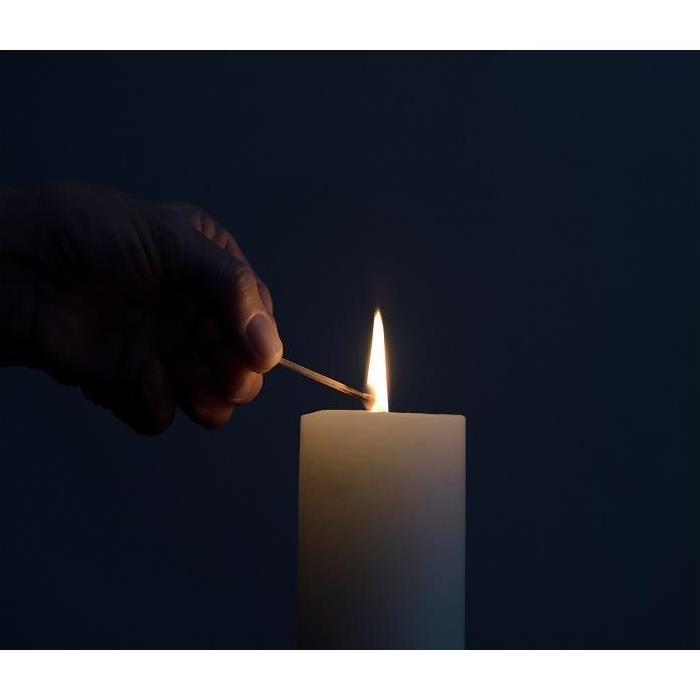 Candle With Care
Candle With Care
Candles may be pretty to look at but they are a cause of home fires — and home fire deaths. Remember, a candle is an open flame, which means that it can easily ignite anything that can burn.
Candle FACTS:
- December is the peak month for home candle fires.
- More than 1/3 of home candle fires started in the bedroom
- Three of every five candle fires start when things that can burn are too close to the candle
If you do burn candles, make sure that you...
- Blow out all candles when you leave the room or go to bed.
- Keep candles at least 1 foot away from anything that can burn.
- Use candle holders that are sturdy, and won’t tip over easily.
- Put candle holders on a sturdy, uncluttered surface.
- Light candles carefully. Keep your hair and any loose clothing away from the flame.
- Don’t burn a candle all the way down, discard before it gets too close to the holder
- Never use a candle if oxygen is used in the home.
- Have flashlights and battery-powered lighting ready to use during a power outage.
Should disaster strike and you become a victim of a home fire, call SERVPRO of Champaign / Urbana at 217-355-0077 we are Here To Help and Faster To Any Disaster.
Selecting the right fire extinguisher
9/9/2020 (Permalink)
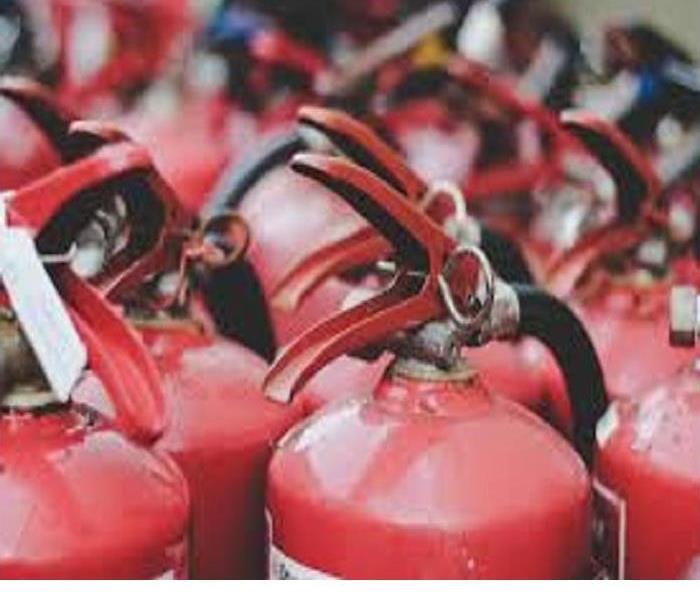 Fire Extinguisher Knowledge
Fire Extinguisher Knowledge
Getting the right type of fire extinguisher is very important for your home or business. What is the right type? The most common fire extinguisher is a stored pressure fire extinguisher. However, there’s another type of fire extinguisher, cartridge-operated, that we will discuss in this blog. A cartridge-operated extinguisher looks and functions differently than a stored pressure extinguisher. It’s important you understand the differences in these extinguishers so that you can safely and accurately use the fire extinguisher in the event of an emergency.
Operating a Fire Extinguisher
A stored pressure extinguisher has the agent and pressure mixed in the same container inside of the extinguisher. A cartridge-operated extinguisher has just powder/agent inside and there is a separate pressure cartridge that has to be activated to pressurize the extinguisher. The way these extinguishers are manufactured affects the way they are operated. A stored pressure extinguisher can be operated by using the PASS method. The cartridge-operated extinguisher has an added step. Since there is a pressure cartridge, you’ll need to activate the cartridge first, which immediately adds pressure to the inside of the extinguisher. Once the cartridge has been activated, you can then aim, squeeze, and sweep to extinguish the flames.
Inspection & Maintenance
The inspection and maintenance are different for both extinguishers. A stored pressure fire extinguisher has a quicker inspection process, only taking about ten steps. They need an internal examination every six years and a hydro-static test every twelve years. A cartridge-operated fire extinguisher has a longer inspection process, with about 43 total steps. There is a hydro-static test needed every 12 years, but a 6-year internal examination is not required.
Both types of extinguishers should be inspected every month by an appointed individual at your facility. The monthly inspection is done to ensure the extinguishers:
- Are in their designated locations
- Are accessible
- Instruction labels are legible
- All seals and tamper indicators are sound
- There are no signs of corrosion, damage, leakage, or clogging
You will need to keep a written record of each manual inspection.
Why Choose a Cartridge-Operated Extinguisher?
This is a common question asked because cartridge-operated extinguishers are extremely unfamiliar to the public. However, cartridge-operated extinguishers do well in facilities with low temperatures or places exposed to adverse conditions. While cartridge-operated extinguishers are more durable, they are also heavier. They have fewer accidental discharges, but tampering with the agent is possible since the pressure is not stored inside of the extinguisher. Newer cartridge-operated extinguishers include an indicator, so you’re aware when pressure has been activated; however, it is not required. The pressure gauge on a stored-pressure extinguisher is still considered an advantage.
Should you have the unfortunate chance of having a fire at your home or business give SERVPRO of Champaign/Urbana a call today at 217-355-0077. Our friendly staff is here to help with 30 years of experience in the restoration business!
National Pet Safety Day
6/22/2020 (Permalink)
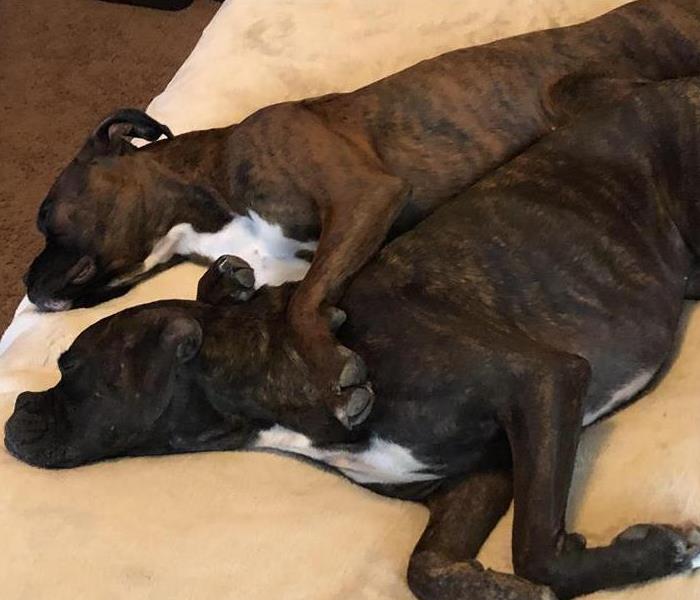 dogs laying on the bed
dogs laying on the bed
Many are unaware that nearly 1,000 residential fires a year are started by pets. We love our four-legged friends, but their natural curiosity can cause a devastating fire, especially when they’re left alone. To bring awareness to this, National Pet Fire Safety Day was created to take place every July 15th.
National Pet Fire Safety Day was created in 2007 by the American Kennel Club and ADT Security Services. The day is intended to educate pet owners about simple changes they can make that will help prevent house fires caused by pets. These changes could save your home or even the life of you and your pet.
Be Mindful Of Open Flames
Candles, stoves, and fireplaces should be carefully watched if pets are around. Besides being curious creatures who will sniff and paw at the pretty flames, wagging tails can also catch embers and knock over candlesticks.
Remove Stove Knobs
This may sound extreme, but having knobs on your stove that pets can turn has caused many house fires. If your dog is tall enough to reach the stove knobs, remove them or invest in safety knobs that won’t turn. This can save a lot of heartache later.
Forget Glass Water Bowls
Trade any glass water bowls for plastic or metal. If a glass water bowl is sitting outside on a sunny day, it can result in a “burning ants with a magnifying glass” effect and cause a fire on a wooden deck or even in the grass.
Use Fire Alert Window Clings
Many pet owners take advantage of fire alert window clings to help firefighters find which room their pets are located in in the event of a house fire. These window clings should always be updated to include how many pets you have in the house and should be on the window of every room where they are kept while you’re away.
Hide Your Electrical Cords
If your dog is a chewer, secure any electrical cords by covering them up or hiding them. An electric blanket can also be very deadly. A chewed-on cord can become damaged and spark, creating a risk for fires. Some pet owners even choose to unplug their electronics completely while they’re away, if their pets are big chewers or clawers.
Have A Plan
It’s very important to have an emergency plan in case of house fires, whether they’re started by your pet or not. Sadly, an estimated 40,000 pets die in house fires each year, so it’s absolutely crucial to have a solid plan in place. Practice escape routes with your pet, and be sure to include all members of your family to make sure everyone understands exactly what to do.
Anyone who owns a pet, specifically families with younger children, should take advantage of National Pet Safety Day and go over these safety measures and even have a safety drill to practice. Questions? Give one of our friendly staff here at SERVPRO of Champaign/Urbana a call by dialing 217-355-0077 today! We are here to help!
Firefighters Are Heroes
6/12/2020 (Permalink)
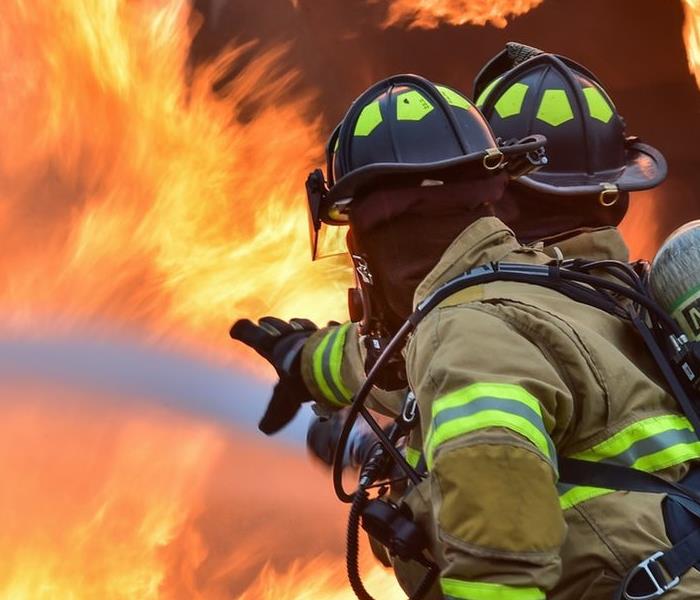 firefighter fighting a fire
firefighter fighting a fire
Since 1678 firefighters have been saving the lives of Americans. Although their techniques have changed since then, firefighters are still saving thousands of lives nationwide each year. This is very heroic, no dispute here, but is this the only thing that makes a firefighter a hero? Not by a longshot and here is why.
Firefighters Are Heroes Because They Run Towards the Danger
Fires and explosions make most people flee and run away or stand by and watch. Not true for a firefighter, they run towards the fire. When disaster strikes, firefighters are one of the first officials to reach the scene. Even in medical emergencies, firefighters are responding to the call. It takes raw courage to be a firefighter. They know that there’s a chance that things might not go their way. They have family and friends they hold dear just like all of us, but they push through anyway. General Norman Schwarzkopf once said, “True courage is being afraid, and going ahead and doing your job anyhow, that’s what courage is.”
Firefighters Are Heroes Because They Never Give Up
On average, firefighters will work 10, 24-hour shifts per month. Firefighters don’t get holidays or their birthdays off. When you’re with your family around the Christmas tree waiting for Santa, firefighters are out there keeping you safe. While your family is enjoying the fireworks on the Fourth of July, firefighters are standing guard to keep you safe. The threat of coming into contact with Covid-19 does not deter them, they still work tirelessly to keep you safe.
Firefighters Are Heroes Because They’re Also Scientists
Not every fire starts with a match. In some cases, fires start when certain chemicals collide or when an electrical wire gets too hot. There are six known classes of fires. Some include gases, liquids, metals, and oils . Each one requires a different approach and it’s up to the firefighters to decipher which type of fire they’re dealing with.
After subduing the flames, firefighters are tasked with finding the cause. They discover the starting point of a fire by using their knowledge of fire and deductive skills. They use their scientific knowledge of chemistry, physics, and engineering to deduct where and when a fire started. Besides pinpointing the origin, firefighters can also determine if a fire was accident or arson. Honing these skills can help prevent future fires.
Firefighters Are Heroes Because They Inspire Others
Think about all the little boys and girls on Halloween strutting around town in plastic red firefighter hats. Even when you were young, there was always one classmate or friend who wanted to be a firefighter when they grew up. Firefighters are inspirational. Every day they face new dangers and every day they find ways to fix them.
It takes a special kind of person to become a firefighter. They throw themselves out of windows, run through burning buildings and cut people out of cars. Firefighters see and experience things that affect them both mentally and physically. Despite this, they continue to do what they do.
Firefighters Are Heroes Because They Do More than Fight Fires
Being a firefighter means more than just battling blazes. Firefighters save people. Whether you’re hurt, stuck in a car, or stuck in a building, firefighters are there to help. They answer the call in every catastrophe. They even act as emergency medical technicians in some situations. Firefighters care for the sick and injured. They rescue pets, pull animals out of trees, and are very active in their communities. You could make a case that they are the glue of the community.
Firefighters also work to prevent future fires from happening. They install fire alarms, create fire regulations, and teach children fire safety. Firefighters work tirelessly to ensure that their community is taken care of. Because being a firefighter isn’t about the glory or the money, it’s about how many lives you can change. We here at SERVPRO of Champaign/Urbana are so grateful for our firefighters who work tirelessly to make a difference in our communities.
Causes of Fires
5/27/2020 (Permalink)
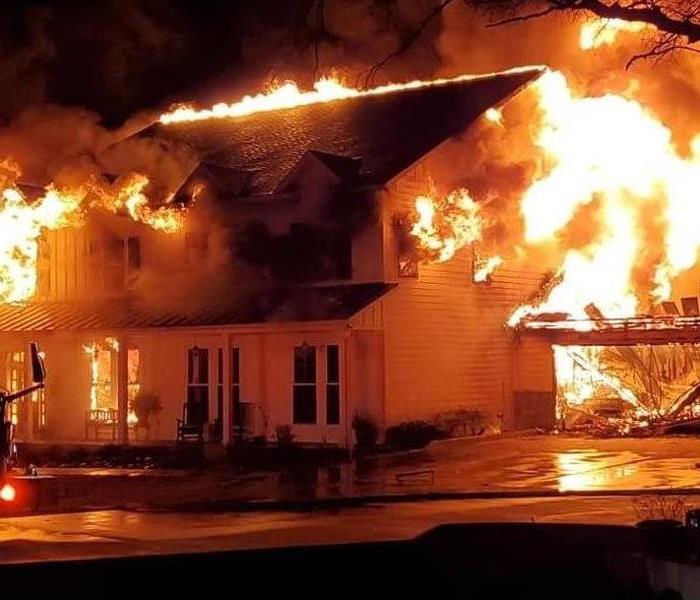 House Fire
House Fire
At SERVPRO of Champaign/Urbana, we’ve dealt with cleaning up fire and smoke damage many times. There have been some very strange, unnecessary, and outright silly reasons that the fire was started in the first place. Fires can be caused by common things (cooking accidents) or completely off-the-wall things (see our list below). Either way, it’s good to know about everything that could create a fire in your home or office in order to uphold the best practices for fire safety. Below are some actual scenarios that are off the wall…
Alcohol + Cigarettes
An Ohio man who was having trouble with bedbugs decided the best way to get rid of them was to spray his infested couch with rubbing alcohol. While he performed this experiment, he was smoking a cigarette. This man obviously caused a house fire and had to be treated for burns.
Homemade Ashtray
A family in Oregon decided to cut a hole in their family room floor to use as an ashtray. (Seriously—why not just buy an ashtray?). Of course, this led to problems. The cigarettes and ashes that the family had been throwing into their “ashtray” caused a fire to break out in their basement, which ended up costing thousands of dollars in damage.
Linseed Oil
This is a mistake that many homeowners make. Linseed oil is one of the biggest underrated enemies of fire safety. It’s used to polish wood, but unfortunately, the oil can also cause fires. It’s safe on wood, but when the oil is left on the rags that people have polished with, it can spontaneously combust causing a fire due to the chemicals building up.
Glass Jars
An elderly woman in South Carolina had empty glass jars lined up on her windowsill. When the sunlight was refracted by one of these jars and was concentrated on her window’s curtains, it caused a fire in her kitchen. This occurrence happens from time to time: refracted light fires have been started by glass doorknobs, glass wind chimes, and even glass panes left leaning against walls.
Microwaving Underwear
A teenage boy in Texas attempted to dry his wet underwear in the microwave. The elastic band on the underwear burst into flames and caused significant fire and smoke damage to the kitchen area. What should and should not go into a microwave should be common fire safety knowledge. When it comes to microwaves, avoid putting in cloth, paper, metal, and plastic.
Wall Air Fresheners
Many residents use those amazing smelling plug-in air fresheners. However, use these with caution. There are several dangerous factors associated with them and they have been the cause of many house fires. Many of them are made from very thin plastic and the wall outlets can get extremely hot. If you leave them plugged in for too long, you’re at risk for a fire. If you use them, unplug them at night or when you leave the house.
No matter how a fire starts, know that SERVPRO of Champaign/Urbana is here to help. Give one of our friendly team members a call at 217-355-0077 today!
Is it safe to stay in a house with smoke damage?
5/18/2020 (Permalink)
 Confined Fire Damage From Microwave
Confined Fire Damage From Microwave
Is it safe to stay in a house with smoke damage?
In short, the answer is no. No matter how big or small the fire that caused the smoke damage, it is a major health risk. Whether it’s the result of a large house fire or a small fire that was contained to one room there are very real dangers to consider.
It’s easy to assume that the smoke from a fire that only affected one appliance and didn’t reach any other rooms will be contained to that area. For example, if the microwave caught fire and was dealt with quickly, it’s not unreasonable to think that the upstairs bedroom wouldn’t possibly be affected by smoke damage. Unfortunately, this isn’t entirely accurate.
While smoke seems to dissipate quickly, it is incredibly invasive. It will find its way into all manner of places around the home, using whatever means possible. Sometimes this means you’ll find smoke damage within HVAC vents, sometimes you’ll find the most smoke damage behind walls. Often it can be found in household furnishings and it’s not uncommon to find smoke damage within light fittings and electrical sockets. Even if you cannot see any smoke there could be still be smoke particles which you cannot see. This is what is so dangerous as it’s the smoke particles which are a health risk.
What is smoke damage?
Smoke damage is the physical damage caused by smoke that’s generated by a fire, not the damage caused by the fire itself. Caused by the remnants of the fuel that fed the fire, smoke does not destroy items like fire does. Instead, it coats objects in soot and odor.
The composition of smoke is complex, but often results in a greasy layer making it particularly difficult to remove. Even so, no matter how small or large the fire, smoke will want to travel to cooler areas and will use whatever means available to get there. This can include ducts, wiring, pipes, or any other crevices. This means that smoke has often reached places you cannot even see. While smoke may seem to dissipate quickly the quick cooling of the particles leave a film and odor able to penetrate the contents of a building and its structure.
Can fire smoke damage make you sick?
Fire damage is heat damage and is what causes objects to melt and burn. Smoke damage doesn’t destroy items like fire damage does. However, they are both incredibly hazardous to health. The number one cause of death related to fires is smoke inhalation. This occurs when the products of combustion are inhaled during a fire.
Smoke is a mixture of heated particles and gases and it’s impossible to predict its exact make up. The items burned, temperatures reached and the amount of oxygen available all play a critical part in determining the type of smoke produced. For example, wood fires create a completely different kind of smoke to protein fires.
Not only can smoke inhalation cause burns to the respiratory system, but it can cause further complications which can result in death or permanent damage. Coughing, vomiting, nausea, confusion and sleepiness are all signs of smoke inhalation. During smoke inhalation, you have more carbon monoxide in your lungs which prohibits oxygen into your body. Prolonged exposure to smoke inhalation can result in death or permanent brain damage.
Health risks of staying in a smoke damaged house
Many people might think that the health risks of fires are removed once the fire is put out, sad to say, this isn’t entirely accurate. Smoke can be incredibly toxic. Tar and carbon are just two of its common byproducts, but smoke can also contain heavy metals and other toxins. If these are breathed in over a period of time, they can go on to cause health implications.
Breathing can become difficult if staying in a smoke damaged house. Lungs and sinuses can be affected directly making breathing hard. Residual particles in clothing and furnishings can irritate the skin, which normally cannot be treated with lotions. Sometimes, these skin irritations can be severe. To be safe, even if you cannot see any smoke damage it’s vital that you have SERVPRO of Champaign/Urbana come in and complete a thorough clean and decontamination of the entire property.
Summary
It’s not just the immediate fire that’s a risk to your health. Staying in a property that’s had a fire, whether you can see smoke damage or not, is a risk to you and your family's health. Give SERVPRO of Champaign/Urbana and speak to one of our friendly team members today at 217-355-0077! We are here to help!
Difference Between Fire Classes
3/10/2020 (Permalink)
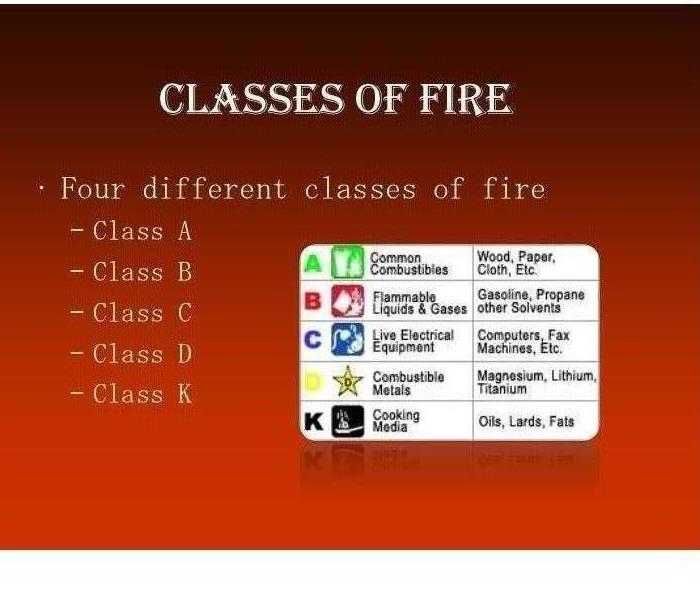 The Different Classifications of Fires
The Different Classifications of Fires
The fire classification system is designed to categorize fires into groups based on the type of fuel involved. Each fire class is represented by a letter of the alphabet (with the electrical which are simply referred to as “electrical fires”) and an icon. This helps users to select an appropriate fire extinguisher in the event of a fire.
Class A Fires
- Solid Combustibles
- Fire involving solid combustible materials such as wood, textiles, straw, paper, coal etc.
Class B Fires
- Flammable Liquids
- Fire caused by combustion of liquids or materials that liquefy such as petrol, oils, fats, paints, tar, ether, alcohol, stearin, and paraffin.
Class C Fires
- Flammable Gases
- Fires caused by combustion of gases such as methane, propane, hydrogen, acetylene, natural gas and city gas.
Class D Fires
- Flammable Fires
- Fires involving combustibles metals such as magnesium, aluminum, lithium, sodium, potassium and their alloys. Combustible metal fires are unique industrial hazards which require special fire extinguishers.
Class F Fires
- Combustible Cooking Media
- Fires involving particularly hot or deep oil and grease fires, such as deep fat fryers in commercial kitchens or overheated oil pan fires in homes. Normal water-based extinguishers with large droplets would cause an ‘explosion’ of stream and carry burning oils and fats from the container. Equally, a CO2 extinguishers jet would carry burning oil out of the container and also would have in-sufficient cooling effect to stop reigniting. Wet chemical extinguishers, on the other hand, lay a cooling foam layer on top of the burning fat/oil and react with the liquid, stopping air supply to the fire.
Electrical Fires
- Electrical Appliances
- Fires involving electrical appliances such as computers, electrical heaters, stereos, fuse boxes etc.
Call SERVPRO of Champaign/Urbana for any of your fire needs, 24/7 at (217) 355-0077.
Fire Damage Restoration, Are You Prepared?
2/26/2020 (Permalink)
An incident that requires fire damage restoration can happen unexpectedly, but that doesn't mean you can't be prepared. During a fire, the safety of you and your family matter first. Knowing what to do during and after the event will help to keep your family, and your property as safe as possible. Here are some tips to help during a home fire.
Fire Damage Restoration
Getting out of your home
Small flames can grow into a large in as little as 30 seconds, and it only takes a few minutes for black smoke to fill the house. Along with the intense heat of a fire, what some people may not realize is how dark a room can become due to the thick smoke.
To be prepared you should:
- Practice making your way out of your house without the ability to see
- Locate multiple ways out of each room in your home
- Have a folding ladder in upstairs rooms to escape out of windows
Once the fire has been eliminated
Caution should always be taken entering your home until the restoration process is complete. Before entering your home again, be sure to check with the fire department to ensure it is safe to re-enter. Upon doing so, be mindful of any possible structural damage, and collect as many valuable documents and records as possible.
Contacting a Fire Damage Restoration Company
As soon as possible, call your insurance company. Keep in mind that your insurance company may have a national account they suggest, but you don’t have to use the company they suggest. After that, be sure to call a restoration company. Fire damage restoration varies in the time it takes to complete depending on the extent of the damage. The aesthetics is just the beginning of what's necessary to restore a home. Soot can be very hazardous to your health and is best handled by a professional. There is also the risk you could be exposed to electrical elements that should be professionally handled.
If you have experienced a fire and need fire damage restoration, don't wait, call SERVPRO of Champaign-Urbana anytime at (217) 355-0077.
(SB)
Why you want SERVPRO on Your Side After a Fire.
12/30/2019 (Permalink)
The chill of winter is here and with it, an increased risk of fire. The Red Cross reports that the rate of home fires increase in winter months due to factors such as space heaters, Christmas lights and increased use of fireplaces.
While we all hope a fire will never happen to us, planning for what to do in case it does is wise. This includes creating a fire escape plan for your household but also choosing what restoration company to work with to mitigate the damage. By deciding this in advance, you will be able to better react should a fire occur.
Choosing a fire restoration company is one of the most important things to look at, a fire restoration company is who will be able to restore your house and its contents to the pre-fire state. That is why we utilize three methods of deep-cleaning to ensure your life can resume like normal. Our trained technicians of SERVPRO of Champaign-Urbana can handle:
Structural Cleaning
Fire damage can seep into every aspect of your home, even requiring the structural elements to need thorough cleaning. By doing a pretest, we will determine the extent of the damage first thing, then begin cleaning the required surfaces with the recommended equipment and cleaning solutions. This can involve cleaning soot deposits off surfaces and preparing walls for repainting by preparing the surfaces to adhere to paint.
Content Cleaning
What fills your home is just as valuable as the home itself, which is why we promise to take care of your belongings and restore what we are able to. We can clean and deodorize area rugs, furniture and upholstery in most cases, utilizing either wet or dry cleaning processes. All other belongings that are eligible will also be restored to pre loss conditions, including electronics, furniture, clothing and more.
Deodorization Services
Fire can leave behind tenacious smoke odors, but it can also leave behind hazardous soot particles that can lead to health issues. Instead of utilizing artificial fragrances to mask the odors, we are able to go to the source and remove them by utilizing air scrubbers and other tools. With a variety of deodorization methods available, we will work with you to find what is best for your situation.
If you’ve been affected by a fire, reach out right away! You can call us anytime at (217) 355-0077.
(SB)
Smoke Detectors
9/2/2019 (Permalink)
You really can never be too prepared.
Fires can happen anywhere, at any time...under the right conditions. The preventative measures you take prior to a potential fire loss could save your home, or more importantly your life!
Replacing the batteries in your smoke detectors twice a year is a must. A good rule of thumb is when you change the clocks change the batteries in the smoke alarms, this will provide consistent battery life in your detectors. This gives you a chance to check your smoke detectors to make sure they work properly. Put an evacuation plan together. Make sure your loved ones and those living with you know what to do in the event of a fire. Having a central location to meet once everyone is outside is a great plan.
After you and your loved ones are safe, call SERVPRO to make it "Like it never even happened." Reach us in the office 24/7 at (217)355-0077, we are always here to help you in your time of need.
Smokewebs
8/28/2019 (Permalink)
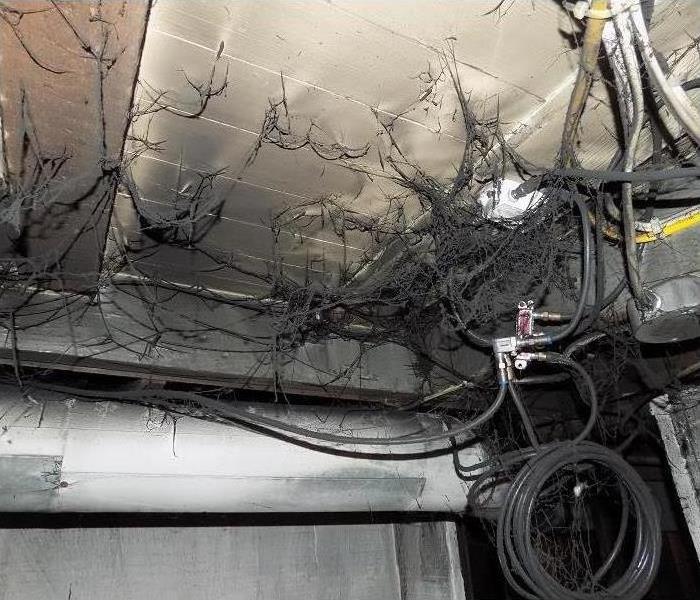 SERVPRO of Champaign/Urbana, Your fire and water cleanup and restoration professionals!
SERVPRO of Champaign/Urbana, Your fire and water cleanup and restoration professionals!
This isn't your typical Halloween decoration. In fact, these are not made from cobwebs at all. This is what is known as "Smokewebs."
Smoke webs occur when the ionization process of burning synthetic materials (rubber, plastics, etc.) create charged particles that tend to cling to certain surfaces. These charged particles will attract to themselves repeatedly and form "chains" of soot. Smoke webs are especially common in low heat or smoldering fires which produce "wet smoke." The webs are common in stagnant air spaces such as the corners and edges of ceilings or cabinets. Soot from synthetic materials is tacky, pungent, and smears very easily with conventional cleaning products. Our Production Staff uses professional grade chemicals specifically designed for smoke and soot produced by any material.
No matter how big of fire damage, you should always contact your local SERVPRO. We'll make it "Like it never even happened." Call us 24/7 at (217)355-0077.
Champaign/Urbana Some and Soot Cleanup
8/5/2019 (Permalink)
Smoke and soot is very invasive and can penetrate various cavities within your home, causing hidden damage and odor. Our smoke damage expertise and experience allows us to inspect and accurately assess the extent of the damage to develop a comprehensive plan of action.
Smoke and soot facts:
- Hot smoke migrates to cooler areas and upper levels of a structure.
- Smoke flows around plumbing systems, seeping through the holes used by pipes to go from floor to floor.
- The type of smoke may greatly affect the restoration process.
Different Types of Smoke
There are two different types of smoke–wet and dry. As a result, there are different types of soot residue after a fire. Before restoration begins, SERVPRO of Champaign / Urbana will test the soot to determine which type of smoke damage occurred. The cleaning procedures will then be based on the information identified during pretesting. Here is some additional information:
Wet Smoke – Plastic and Rubber
- Low heat, smoldering, pungent odor, sticky, smeary. Smoke webs are more difficult to clean.
Dry Smoke – Paper and Wood
- Fast burning, high temperatures, heat rises, therefore, smoke rises.
Protein Fire Residue – Produced by evaporation of material rather than from a fire
- Virtually invisible, discolors paints and varnishes, extreme pungent odor.
Our Fire Damage Restoration Services
Since each smoke and fire damage situation is a little different, each one requires a unique solution tailored for the specific conditions. We have the equipment, expertise, and experience to restore your fire and smoke damage. We will also treat your family with empathy and respect and your property with care.
Have Questions about Fire, Smoke, or Soot Damage?
Call Us Today – (217) 355-0077
Fire=Soot
8/5/2019 (Permalink)
Fire disasters not only cause FAST damage but it also causes lasting damage. When you have a fire in your home or business it is not just the flames that are dangerous, it is the smoke as well. We have specialized trained employees who take their time to make sure there are absolutely no remains of soot on your personal belongings after your fire disaster.
- Dry Cleaning - Used for cleaning light residues or to pre-clean prior to wet cleaning.
- Wet Cleaning - An effective cleaning method for removing moderate to heavy residues.
- Spray and Wipe -Effective for items that can’t withstand wet cleaning.
- Foam Cleaning - Used for upholstery fabrics that might shrink or bleed if wet cleaned.
- Abrasive Cleaning - Involves agitation of the surface being cleaned.
- Immersion Cleaning - Contents are dipped into a bath of the cleaning product.
We here at SERVPRO of Champaign/Urbana know how devastating water, fire, mold, or asbestos disaster can be and we are dedicated to helping you get through it. Give us a call today at (217) 355-0077. We are available 24 hours a day, 7 days a week.
Every Second Counts
6/13/2019 (Permalink)
In a fire, seconds count. Seconds can mean the difference between residents of our community escaping safely from a fire or having their lives end in tragedy.
This reinforces why everyone needs to have an escape plan. Here are some key messages to employ:
- Draw a map of your home with all members of your household, marking two exits from each room and a path to the outside from each exit.
- Practice your home fire drill twice a year. Conduct one at night and one during the day with everyone in your home, and practice using different ways out.
- Teach children how to escape on their own in case you can’t help them.
- Make sure the number of your home is clearly marked and easy for the fire department to find.
- Close doors behind you as you leave – this may slow the spread of smoke, heat, and fire.
- Once you get outside, stay outside. Never go back inside a burning building.
via http://www.nfpa.org/
Have you contacted your local fire department? See how you can get involved with them and your community to prevent house fires. Sometimes they will have events or give out smoke detectors for your home. Don't think this could never happen to you because it easily could. We don't have control over everything in our homes! Be safe and have a plan!
Contact us at (217)355-0077!
[JB]
Residential Lightning Damage Happens More than You Think
6/4/2019 (Permalink)
Strikes happen an average of twice a year!
Here at SERVPRO of Champaign/Urbana, we can help you with fire damages caused by lightning strikes. When the lightning hits a residence, it travels through the electrical lines to one of the home’s electrical boxes, which can catch fire. These fires can leave severe damage, including smoke damage to your home. SERVPRO of Champaign/Urbana’s mitigation team has the ability to do a chem-sponge technique that is used to clean soot off of the walls. In doing this, SERVPRO of Champaign/Urbana can ensure that no fire damage or smoke damage goes untreated. If needed, affected walls in all damaged rooms can be painted after the cleanup is completed and drywall replaced where necessary. Our professional in-house crew use a white-glove treatment on your residence and can complete the entire project quickly; from the first contact to completion. Here at SERVPRO of Champaign/Urbana, we are proud to serve the residents of Champaign/Urbana, Illinois, especially when the worst happens. Why chose SERVPRO? Because in the event of fire or water damage, large or small, we’re here to help. Call us in Champaign/Urbana at (217)355-0077. [JB]
Why Board-Up After A Fire is Important.
5/10/2019 (Permalink)
If your property in Champaign/Urbana has experienced a fire, there are several reasons why you might want to board up structural damage or windows. In addition to keeping the external elements out of a building with fire damage, boarding up can also prevent additional losses due to looting and make the fire cleanup process easier. SERVPRO of Champaign/Urbana offers full-service restoration specialists who can also assist in board-up services.
Here are four reasons to board-up after a fire!
- In a commercial setting, there may still be viable stock on the premises. If products that appear viable remain in the building, you should consider boarding up. These items may require assessment, cleaning and may not be fit for sale, but having them properly processed rather than stolen can be helpful for insurance purposes.
- You want to protect electronics and other valuables. Depending on the extent of the fire damage, you may be able to restore some electronics or other valuable property to working condition.
- You need to keep out the elements. If the structure of your property has extensive damage, you should try to keep the elements out to prevent additional damage. Exposure to additional water, wind, or sunlight can compound the damage caused by smoke residue and soot.
- You want to limit soot damage as well. It is generally a good idea to reduce foot traffic on the scene of a recent fire. When soot gets embedded into carpeting or upholstery, it can be much more difficult to restore these materials to a pre-fire condition.
Talk to our experts at SERVPRO of Champaign/Urbana to board up any structure, which is always a good strategy for preventing further loss and limiting damage after a fire. Your major concern is likely to be how to recover from fire damage as quickly and completely as possible. Preventing looting and exposure to the elements can make fire cleanup more successful. Call SERVPRO of Champaign/Urbana anytime at (217) 355-0077.
(SB)
Why SERVPRO? Because We Do It All!
4/17/2019 (Permalink)
We worry about your restoration emergency so you don't have to.
From start to finish, you will see that SERVPRO of Champaign/Urbana will take care of your restoration emergency from start to finish. A fire, for example, can wreak havoc not only on your home or office but your precious time and checkbook too. There is no need to worry. Not only do we possess the experience, but the equipment and talent on our team to make sure the disaster looks like it never took place. After removing any drywall that is burned and unsalvageable, we will make sure your home down to the studs is clean and smelling great. Besides any demolition that needs to be done, we will begin reconstructing your home back to the way it was. This includes painting your walls as well. It will be like an entirely new room in your home.
If you have recently experienced a restoration emergency, let our team here at SERVPRO of Champaign/Urbana take care of everything so you don’t have to. We will always work with you each step of the way and make sure you are satisfied. Give us a call at (217)-355-0077 for more information. [JB]
3 Fire Hazards to Avoid This Spring
4/15/2019 (Permalink)
Springtime is such a fun, beautiful time of year. Stay safe out there!
The weather is warmer, the trees are blooming, and my allergies are killing me. Spring has officially sprung! That being said, there are still a wide variety of fire hazards that you should watch out for, even during the warm months.
1.Grills: Whether you’re cooking burgers for the family event or grilling up kabobs for dinner, you will inherently deal with a fire. Most are gas grills, which presents an even greater risk. In fact, the NFPA (https://www.nfpa.org/News-and-Research/Data-research-and-tools/US-Fire-Problem/Home-Grill-Fires) reports that an average of 9,600 home fires is caused by grilling each year. Here are some fire safety tips for the grill:
- Always check for any potential fire hazards before firing up the grill.
- If the grill does not light the first time, let the gas dissipate for at least 5 minutes before attempting to light the grill again.
- Be sure the grill is clean before using to get rid of oil and gas residue.
- Make sure the grill is set up in an open, outdoor area and keep it a good distance from the house and railings.
- Dryers: This is a fire hazard year round. In fact, the leading cause of clothes-dryer related fires is a failure to keep the lint baskets clean. Lint is combustible. Lint causes fires. It takes seconds to clean out the lint basket, so just make a habit of it when you get your clothes out of the dryer. If you have space for a clothesline in the spring and summer months - use it! There’s nothing better than fresh, air dried clothes. The NFPA also recommends cleaning out the vent pipe at least once a year so lint or other flammable particles do not get stuck in the vent pipe.
- Outdoor Fire Pits and Bonfires: The necessary safety precautions for an outdoor fire pit are pretty obvious, but keep these in mind when you’re having a party on a cool spring night.
- Always have an adult present around a fire. Never leave children unattended!
- Always have a bucket of water or a water hose available nearby if things get out of hand.
- Build the fire away from homes, porches, low-hanging trees, or any other fire hazards.
- Monitor the number of leaves, pine needles, paper, and other contents are fed into the fire since these items catch fire quickly and result in high flames and floating embers.
- Always put the fire out completely before leaving the fire unattended. Don't expect it to die down on its own!
We are always Here to Help when you need us. Call us at SERVPRO of Champaign-Urbana any time at (217)355-0077. Happy Spring!
Smoke and Soot Cleanup
2/7/2019 (Permalink)
Smoke and soot is very invasive and can penetrate various cavities within your home, causing hidden damage and odor. Our smoke damage expertise and experience allows us to inspect and accurately assess the extent of the damage to develop a comprehensive plan of action.
Smoke and soot facts:
- Hot smoke migrates to cooler areas and upper levels of a structure.
- Smoke flows around plumbing systems, seeping through the holes used by pipes to go from floor to floor.
- The type of smoke may greatly affect the restoration process.
Different Types of Smoke
There are two different types of smoke–wet and dry. As a result, there are different types of soot residue after a fire. Before restoration begins, SERVPRO of Champaign/Urbana will test the soot to determine which type of smoke damage occurred. The cleaning procedures will then be based on the information identified during pretesting. Here is some additional information:
Wet Smoke – Plastic and Rubber
- Low heat, smoldering, pungent odor, sticky, smeary. Smoke webs are more difficult to clean.
Dry Smoke – Paper and Wood
- Fast burning, high temperatures, heat rises therefore smoke rises.
Protein Fire Residue – Produced by evaporation of material rather than from a fire
- Virtually invisible, discolors paints and varnishes, extreme pungent odor.
Our Fire Damage Restoration Services
Since each smoke and fire damage situation is a little different, each one requires a unique solution tailored for the specific conditions. We have the equipment, expertise, and experience to restore your fire and smoke damage. We will also treat your family with empathy and respect and your property with care.
Have Questions about Fire, Smoke, or Soot Damage?
Call SERVPRO of Champaign/Urbana anytime at (217) 355-0077.
Winter Heater Reminders
2/4/2019 (Permalink)
We all need heat when temperatures plunge! However, special care must be exercised when using space heaters.
Space heaters that require fuel should be handled and used with extreme caution. While fuel-powered space heaters are more efficient at heating a large space, there are certain things you must do to protect yourself from a potential fire.
Never leave space heaters running without supervision. It's understandable that you do not want to come home to a cold house, but leaving a space heater running unattended is extremely dangerous. Space heaters may overheat which increase the possibility of igniting the fuel and causing a fire.
Here are some helpful tips to keep your home safe:
1: Always make sure the space heater is turned off before refueling
2: Remove the space heater from the residence before refueling. Never refuel inside the house!
3: Allow the space heater adequate time to cool down. Refueling a space heater while it is still hot can cause an explosion. If you spill gas onto one of the hot parts of the space heater, it could easily ignite.
4: Make sure to check if the space heater you are using is approved for indoor use. Most fuel powered space heaters are designed for outdoor use only!
5: Always be sure to double check your home fire extinguishers to insure that they are charged and that the expiration date has not passed.
6: Do not place space heaters on carpets or other flammable fabrics. Make sure the space heater is not in a confined space where it may overheat
7: Electric space heaters should never be plugged to power in a damp room. Humid air can caused the space heater to short, leading to an electrical fire.
8: Always make sure that electric space heaters are directly plugged into an outlet. Extension cords increase the risk of shorting.
9: Before purchasing any space heater, make sure that the space heater has passed safety tests in the United States. The easiest way to tell is to check for an Underwriters Laboratory Label (UL).
SERVPRO of Champaign-Urbana stands ready to remediate any incidence of damaging fire. However, we offer these few watchwords to minimize the prospect of a building fire when using space heaters of any type. (JB)
Dealing with Smoke Damage Problems
2/1/2019 (Permalink)
Smoke damage leaves your property with black marks which can be unpleasing to look at. It destroys the appearance and structure of everything in it. This includes walls, ceiling, furniture and any other item in the affected room. It also leaves the building with an unpleasant odor that is hard to eliminate unless you turn to professionals like us for assistance. We are here to assist any smoke damage victims in the Champaign/Urbana area by offering friendly yet professional services to deal with the disturbing issue and restore your home or business property to its previous state.
We use our experience and high-tech equipment to make sure that we clean and deodorize the building making it a comfortable place to live in. Smoke, due to its nature, can easily seep through the smallest cracks. It is, therefore, hard for you to notice it and this could lead to substantial damages when the issue gets out of hand.
Our team is qualified and has knowledge about how smoke works. This makes us the best option for you. We offer complete cleanup and odor removal in Champaign/Urbana. We do this by following simple yet effective steps as follows;
Removing soot from the household
This is the residue left behind after the smoke damage. It is the action taken after assessing the level of the damage and marking the affected areas.
Determining and getting rid of the source of odor
The smoke smell remains in carpets, upholstered furniture and clothing unless it is eliminated before the cleaning process. We use high-quality additives and chemicals to help break the molecules and get rid of the smell.
Cleaning the room
After deodorizing, it is time to eliminate the smoke spots by doing a thorough cleaning of the walls, carpets and the washable clothes ensuring that they are all left immaculately clean.
If you are having a smoke damage issue in the Champaign/Urbana area, we are the right solution for you as;
- We are experienced
- Have the right equipment
- Certified to do the job
- We offer emergency restoration services
Do not think twice about trusting us to do the job for you and you will not regret your decision.
For any fire smoke damage issues, call SERVPRO of Champaign/Urbana.
217-355-0077 (JB)
10 Tips To Make Your Home Safer From Fires
12/24/2018 (Permalink)
It’s an unfortunate tragedy. Your home in Champaign/Urbana has been ravaged by a raging fire. A restoration company has come to the rescue to return your home back to its prior condition. Hopefully you will never experience such loss again, but it is wise to prepare your home in the event of future disasters. Even if your home has never been devastated by a fire, the following fire preparation tips can prove beneficial in giving you greater peace of mind regarding fire safety in your home.
1. Smoke alarms: Test smoke alarms monthly and replace batteries annually.
2. Prepare children: Teach fire preparation to children, including the dangers of fire. Make sure they know the proper use of 911 for emergencies. Keep matches and lighters out of their reach.
3. Plan where to go: Create an escape plan and make sure everyone in the household is aware of it. Choose an outside meeting spot for all family members to gather upon escaping. Conduct practice drills at least twice a year.
4. Share contact information: Make sure all household members know who to contact in the event that they cannot find each other during a home fire.
5. Educate on proper techniques: Teach everyone in the household to stop, drop and roll in the event their clothes catch on fire.
6. Take action if you smoke: Smokers should take extra precautions, as many residential fire deaths are caused by smoking materials. Avoid smoking in bed, especially while sleepy or medicated. It is better to smoke outside.
7. Handle heaters: Portable heaters should be turned off when not in use.
8. Take care of candles: Candles should be extinguished when not in use, and never left unattended.
9. Store other sources of light: Speaking of candles, consider using flashlights during a power outage instead of candles.
10. Examine the home for other fire hazards: Check the electrical wiring and home heating sources to make sure they are safe.
A home fire is a most unwelcome event, but by taking fire preparation seriously, you and your household can hopefully avoid this happening or, at the very least, be better equipped to handle such an emergency when it occurs, Feel free to call SERVPRO of Champaign/Urbana anytime at (217) 355-0077.
SERVPRO is the #1 Company to Call in Champaign/Urbana When Dealing With Fire Damage!
12/3/2018 (Permalink)
Dealing with commercial fire damage on your own can be devastating & stressful. Our techs can help you and give you peace of mind.
Assistance Helps Speed up Recovery after Commercial Fire Damage in Champaign/Urbana
Fires in commercial establishments can be very devastating. Apart from the loss they cause by damaging the structure and contents, they also lead to business closure, which translates to lost revenue. The longer it takes to resume normal operations, the higher the cost of lost opportunities. In the worst cases, the business might even lose customers. We offer restoration services that help commercial establishments recover faster after fire incidents. FSRT certification means our customers benefit from a combination of top-notch equipment and advanced skills sets throughout the restoration process.
The steps taken immediately restoration starts can quicken, or hamper the speed of recovery after commercial fire damage in Champaign/Urbana. Our SERVPRO technicians rely on their IICRC training to do a thorough evaluation before starting the restoration process. Such evaluation helps us establish the primary form of damage. Depending on the materials and items present in the affected area, it could be a case of predominant flame or smoke damage. If it is a case of smoke damage, we need to establish whether wet or dry smoke is the most prevalent. Having such information helps determine the level of agitation, chemical action and dwell time needed for effective cleaning.
Commercial spaces can present unique size challenges. In a space like a warehouse, the sheer size of the walls, ceilings and other areas that require cleaning can prolong the restoration. In a hotel or office space, the challenge could be large surfaces such as glass windows that require special care to avoid problems like streaking. Our SERVPRO crews use special equipment such as mobile scissor lifts, spotting pad holders and extensions poles when cleaning up vast surfaces saving time.
Our SERVPRO team considers the entire restoration process to determine how much effort to put into each phase, which also helps save time. For instance, if restoration involves repainting the affected surfaces, we clean to remove debris and neutralize the acids in smoke residue then restore the visual appeal though painting.
Locally Owned Company with National Resources
Restoring your fire damaged premises should not take too long. Call SERVPRO of Champaign/Urbana to assist. You can reach us at (217) 355-0077 any time.
Holiday Fire Safety Tips
12/1/2018 (Permalink)
Residential fires during the holiday season are more frequent, more costly, and more deadly than at any other time of the year. The U.S. Fire Administration (USFA) reports more than double the number of open-flame fires on Christmas Day than on an average day, and about twice as many on New Year’s Day. And when those fires occur, they do more damage: Property loss during a holiday fire is 34% greater than in an average fire, and the number of fatalities per thousand fires is nearly 70% higher. When the source of the fire is a highly flammable Christmas tree, the toll in property and lives is even greater.
To keep your household from becoming a holiday fire statistic, here are some safety tips to follow.
Cooking
Cooking is the top cause of holiday fires, according to the USFA. The most common culprit is food that’s left unattended. It’s easy to get distracted; take a pot holder with you when you leave the kitchen as a reminder that you have something on the stove. Make sure to keep a kitchen fire extinguisher that’s rated for all types of fires, and check that smoke detectors are working.
If you’re planning to deep-fry your holiday turkey, do it outside, on a flat, level surface at least 10 feet from the house.
Candles
The incidence of candle fires is four times higher during December than during other months. According to the National Fire Protection Association, four of the five most dangerous days of the year for residential candle fires are Christmas/Christmas Eve and New Year’s/New Year’s Eve. (The fifth is Halloween.)
To reduce the danger, maintain about a foot of space between the candle and anything that can burn. Set candles on sturdy bases or cover with hurricane globes. Never leave flames unattended. Before bed, walk through each room to make sure candles are blown out. For atmosphere without worry, consider flameless LED candles.
Christmas Trees
It takes less than 30 seconds for a dry tree to engulf a room in flames, according to the Building and Fire Research Laboratory of the National Institute for Standards and Technology. “They make turpentine out of pine trees,” notes Tom Olshanski, spokesman for the USFA. “A Christmas tree is almost explosive when it goes.”
To minimize risk, buy a fresh tree with intact needles, get a fresh cut on the trunk, and water it every day. A well-watered tree is almost impossible to ignite. Keep the tree away from heat sources, such as a fireplace or radiator, and out of traffic patterns. If you’re using live garlands and other greenery, keep them at least three feet away from heating sources.
No matter how well the tree is watered, it will start to dry out after about four weeks, Olshanski says, so take it down after the holidays. Artificial trees don’t pose much of a fire hazard; just make sure yours is flame-retardant.
Decorative Lights
Inspect light strings, and throw out any with frayed or cracked wires or broken sockets. When decorating, don’t run more than three strings of lights end to end. “Stacking the plugs is much safer when you’re using a large quantity of lights,” explains Brian L. Vogt, director of education for holiday lighting firm Christmas Décor. Extension cords should be in good condition and UL-rated for indoor or outdoor use. Check outdoor receptacles to make sure the ground fault interrupters don’t trip. If they trip repeatedly, Vogt says, that’s a sign that they need to be replaced.
When hanging lights outside, avoid using nails or staples, which can damage the wiring and increase the risk of a fire. Instead, use UL-rated clips or hangers. And take lights down within 90 days, says John Drengenberg, director of consumer safety for Underwriters Laboratories. “If you leave them up all year round, squirrels chew on them and they get damaged by weather.”
Fireplaces
Soot can harden on chimney walls as flammable creosote, so before the fireplace season begins, have your chimney inspected to see if it needs cleaning. Screen the fireplace to prevent embers from popping out onto the floor or carpet, and never use flammable liquids to start a fire in the fireplace. Only burn seasoned wood — no wrapping paper.
When cleaning out the fireplace, put embers in a metal container and set them outside to cool for 24 hours before disposal.
Should you have a fire emergency, no matter how big or how small, we here at SERVPRO of Champaign/Urbana are ready to help 24 hours a day! Call us today at (217)355-0077.
Immediate Fire Restoration and Why It's Important
11/28/2018 (Permalink)
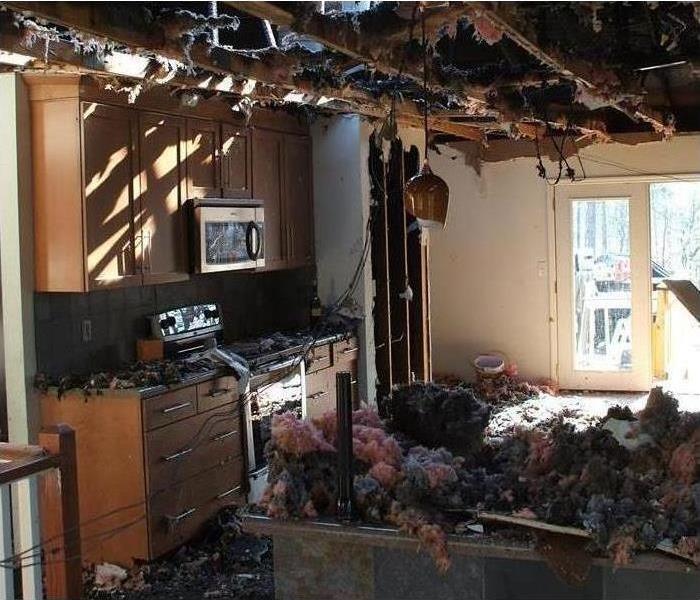
Fires can be a devastating when they occur. It is crucial though when a fire strikes that you get the restoration process started immediately. The longer that it is put off the harder and more repairs will be needed. This also means the price of repairs goes up as well. SERVPRO of Champaign/Urbana specializes in fire damage and restoration. Contacting us is the first step in getting the restoration underway. SERVPRO will try to save as much of your home and personal belongings that we can. Remember that safety comes first, so if there’s no way to safely gain access into your home, stay out until SERVPRO professionals arrive. On arrival we perform a thorough cleanup using our industrial-grade products and equipment, such as dry cleaning soot sponges to remove loose soot and specialized vacuum filters to clean carpet and upholstery. Unfortunately fires happen, but when they do make sure you act quickly to get the damage cleaned up. SERVPRO of Champaign/Urbana takes fire damage and leaves it "Like it never even happened." Call SERVPRO of Champaign/Urbana for your fire restoration needs anytime at (217) 355-0077





 24/7 Emergency Service
24/7 Emergency Service

